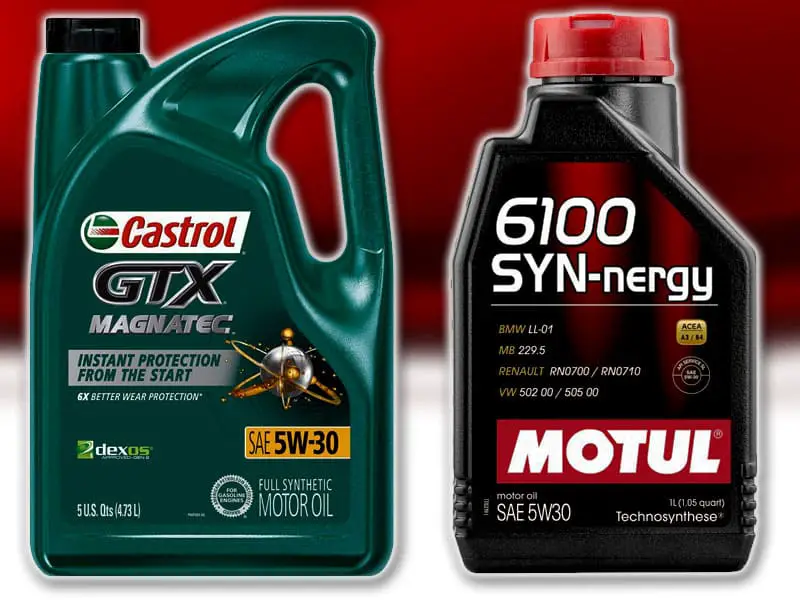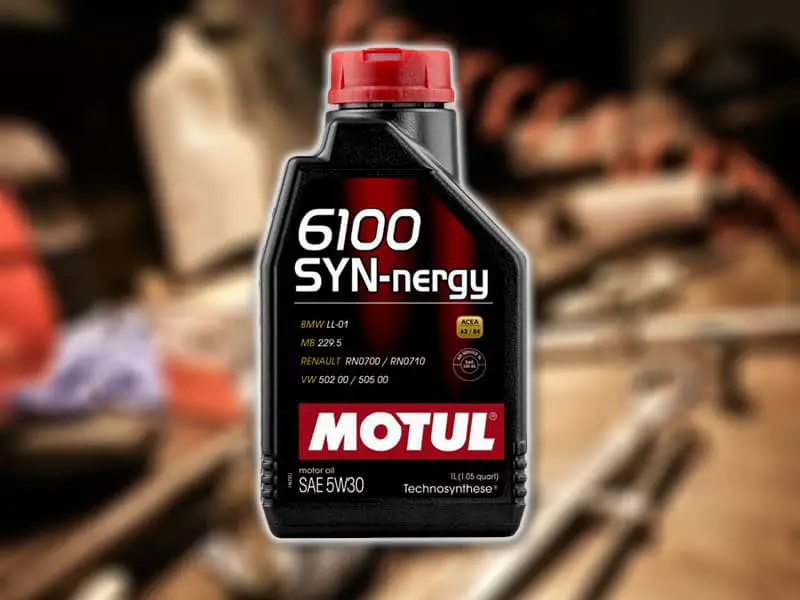Both of the engine oils are specially designed for powerful gasoline and diesel racing cars. Motul 6100 is made from the mixture of synthetic (group IV) and conventional oil (group II) as its base stock, while Castrol is full synthetic made from group IV base oil.
Motul 6100 syn-nergy is an advanced Techno synthese lubricant that provides ultimate wear and sludge protection to automotive engines in extreme temperature. Besides being designed for gasoline and diesel engines, it is also compatible with LPG (Liquefied Petroleum Gas), ethanol, and biofuels. It meets the API SL standard and is recommended not to use for automotive engines that came after 2004. Its fuel economy is phenomenal since it meets the standard of ILAC GF-3.


Castrol Magnatec is well known for its wear protection in stop-start operation. Every time an engine starts or stops, microscopic wear occurs in the engine. When an engine stops, engine oil drains back to its sump, but not Castrol Magnatec. Its molecules stick to the critical engine parts preventing them from wearing. It also protects the engine during warm-up, by proving a self-healing layer.
Compare Castrol Magnatec with Shell Helix Ultra
Compare Castrol Magnatec with Castrol GTX

| Specifications | Motul 6100 Syn-nergy | Castrol Magnatec |
| Oil Type | Synthetic Blend | Full Synthetic |
| Engine Type | Gasoline / Diesel | Gasoline / Diesel |
| Available viscosity grades | SAE 5W – 20, SAE 5W – 30, SAE 5W – 40, SAE 10W – 40 | SAE 5W – 30, SAE 10W – 40, SAE 20W- 50, SAE 5W- 40 |
| ILSAC | GF-3 | GF-5 |
| API | SL | SN |
| Cost of 5W – 30 grade | 34.95$, 5 liters | 16.94$, 5 liters |
| Oil change interval | 10,000 miles | 7,000 miles |
| Additives | Anti-wear additives, Dispersant, Cleaning agents, Viscosity index improvers, Pour point Depressants | Anti-wear additives, cleaning agents, anti-foaming additive |
| ACEA | A3/B4 | A5/B5 |
Table of Contents
Minimizing Engine Wear-Off
Anti-wear additives are being added into engine oils to provide wear protection. Popular anti-wear additives which are being used in modern lubricant oils are zinc, phosphorous, molybdenum, and boron. Their concentration in an engine oil determines its wear protection capability.
By the tested result of the virgin oils given below, it is obvious that Motul has the upper hand in this regard since its combined concentration of anti-wear additives is much higher than its competitor. So when it comes to engines safety, Motul is the best choice among the contenders.
| Additive | Content in Motul 6100 Syn-nergy 5W – 30 (ppm) | Content in Castrol Magnatec 5W – 30 (ppm) |
| Zinc | 933 | 695 |
| Phosphorous | 982 | 672 |
| Boron | 83 | 197 |
| Molybdenum | 2 | 60 |
Viscosity Comparison
Kinematic Viscosity, viscosity index and pour point are three important parameters to consider while comparing viscosities of two engine oils. The kinematic Viscosity of any lubricant oil can be defined as its resistance to flow divided by its density at a certain temperature. Viscosity index tells us about the change in viscosity of any engine oil due to a change in temperature. And the minimum temperature at which engine oil would lose its ability to flow is known as its pour point.
By the characteristic data given below, we can state that the kinematic viscosity of Castrol is lower than its competitor, which means that it would take less amount of power to circulate it in the engine since it poses little resistance to flow.
The viscosity index is related inversely to the change in viscosity because of temperature change. By that trend, it is obvious that Castrol’s viscosity would be affected more by the temperature change.
In cold weather conditions, Motul would be a better option for the engine’s protection since it would not lose its flowing characteristic sooner than its competitor.
| Parameter | Motul 6100 Syn-nergy 5W – 30 | Castrol Magnatec 5W – 30 |
| Kinematic Viscosity at 40o C | 68.6cSt | 54 cSt |
| Kinematic Viscosity at 100o C | 11.2 cSt | 9.6 cSt |
| Viscosity Index | 177 | 164 |
| Pour Point | -43o C | -39 o C |
Catalytic Converter Performance
The performance of catalytic converter can be affected by the poisoning of zinc and phosphorous ash. The ash comes into existence when a small amount of engine oil leaks into the combustion chamber and does get burnt in it. Zinc and phosphorous content in the engine oil serves the purpose of anti-wear additives. The more the amount of these two substances present in the engine oil, the more concentration of ash would be produced and hence the effect of it on the catalytic converter.
The concentration of zinc and phosphorous is comparatively very high in Motul than its competitor, making it more dangerous for the catalytic converter. Castrol would be more preferable in this regard.
| Engine Oil | Concentration of Zinc (ppm) | Concentration of Phosphorous (ppm) |
| Motul 6100 Syn-nergy 5W – 30 | 933 | 982 |
| Castrol Magnatec 5W – 30 | 695 | 672 |
Reduction of Sludge build
At high-temperature conditions, engine oil breaks down at the molecular level and combines with dirt, water molecules, and contamination to form a sticky liquid known as sludge or deposit. To remove it, lubricant manufacturers came up with the solution of adding up cleaning detergents in the engine oil which would wash the sludge away. Commonly added cleaning detergents are magnesium, calcium, and sodium. Their combined concentration in the engine oil would determine the sludge removing capability.
The collective amount of cleaning detergents in Motul is higher than its competitor. Hence it would be a better choice due to its superior cleaning ability.
| Additive | Content in Motul 6100 Syn-nergy 5W – 30 (ppm) | Content in Castrol Magnatec 5W – 30 (ppm) |
| Magnesium | 23 | 715 |
| Sodium | 4 | 5 |
| Calcium | 2490 | 1063 |
Oil Burn-off protection
Whenever the engine gets heated up for an extended period, the engine oil evaporates and eventually burns off. It depends upon its volatility and flashpoint. Volatility is the engine oil’s tendency to evaporate, and flash point is the minimum temperature at which it would burn off once it gets an ignition source. The flashpoint of Motul is comparatively higher than Castrol meaning it would evaporate and burn off much later than its competitor. Hence Motul would be the best choice in this regard since it would not burn off quickly in hot climate conditions.
| Parameter | Motul 6100 Syn-nergy 5W – 30 | Castrol Magnatec 5W – 30 |
| Flash Point | 236 o C | 207 o C |
Oil Change Frequency Comparison
Many hazardous acids come into existence inside an engine due to the side reaction of combustion and oxidation of lubricant oil. Their formation is unavoidable and bound to happen at some point. To neutralize these acids, alkaline-based additives are being added to engine oils. Their ability to neutralize is determined by a parameter known as Total Base Number (TBN). It is measured as the amount of potassium hydroxide (in milligrams) in one gram of lubricant oil. Its value determines the drain interval of lubricant oil. If it gets too low, it would mean that engine oil has low neutralizing ability left in it, and hence it needs to be replaced.
The TBN of Motul is comparatively higher than Castrol and hence its oil changing frequency would be low. That’s what makes Motul far better from an economic perspective than its competitor.
| Parameter | Motul 6100 Syn-nergy 5W – 30 | Castrol Magnatec 5W – 30 |
| Total Base Number | 9.4 mg KOH/g | 7.1 mg KOH/g |
Cost Comparison
The cost of 5 liters of Motul 6100 Syn-nergy 5W – 30 and Castrol Magnatec 5W – 30 is 34.95$ and 16.94$ respectively. Motul is very expensive than its competitor due to its better anti-wear abilities, sludge protection, fuel economy, and the most important is its performance in extreme temperature conditions.
Summary
- Castrol is fully synthetic while Motul is a synthetic blend, both are formulated for gasoline and diesel engines.
- Motul would affect the performance of catalytic converter more than its competitor.
- Sludge cleansing ability of Motul is superior.
- Motul is the best option in extreme temperature conditions.
- Fuel economy of Motul is better due to its lower resistance to flow.
- Oil change frequency of Motul is lower than its competitor.
- Motul is costlier than Castrol.